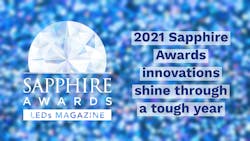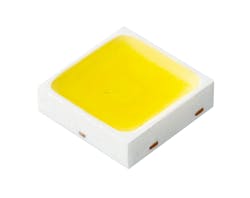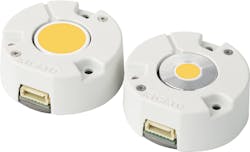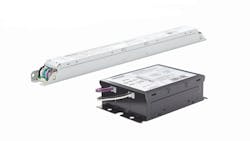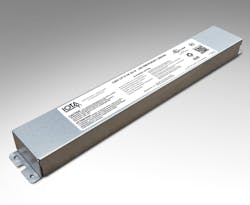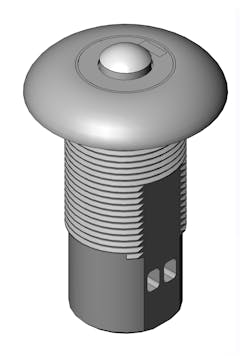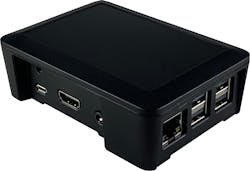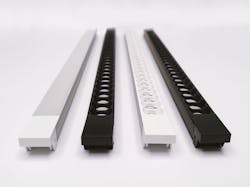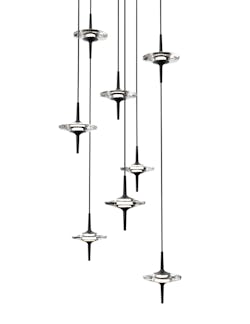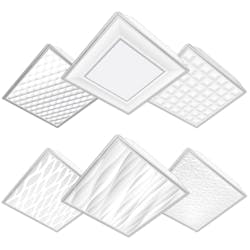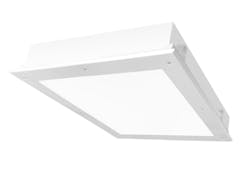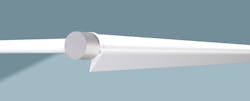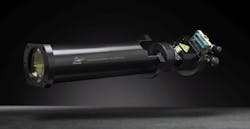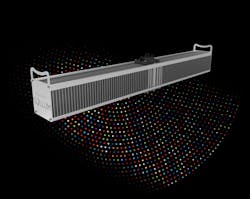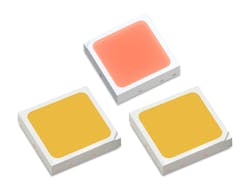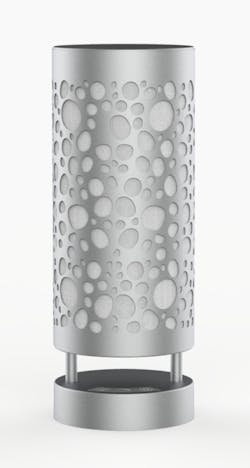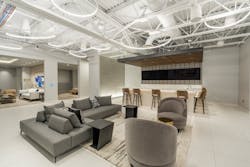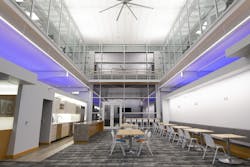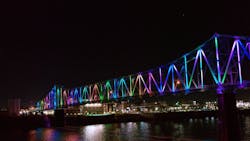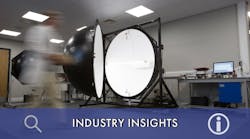In a year-plus overshadowed by dire headlines in the midst of a worldwide pandemic, the team at LEDs Magazine has been inspired by the determination, ingenuity, and forward progress demonstrated by participants in the 2021 Sapphire Awards. Despite business shutdowns, restricted travel, and ongoing impacts across the global supply chain, the pursuit of advanced design and application solutions exemplified by the LED and solid-state lighting (SSL) industry has brought a sense of renewed energy and optimism to the markets we cover. Awards were presented in an online ceremony on Aug. 24, 2021, at the close of the first day of the Strategies in Light conference.
As mentioned in our feature on the seventh annual Sapphire Awards finalists, it was impossible to ignore the driving market trend of ultraviolet (UV) disinfection, not to mention the distinct differences between such technologies and those that employ visible-light wavelengths for germicidal applications. However, the offerings that landed at the top in these two categories tackle two very disparate scenarios — one a commercial- or institutional-scale smart system for disinfection of unoccupied spaces, and one for personal-area use by an occupant with ambient light and air-disinfection functions integrated into a desk-friendly form factor.
New this year are the Design Excellence awards of recognition in partnership with the Lighting Controls Association (LCA). With Sapphire and LCA representatives, Design Excellence project submissions were evaluated for innovative use of lighting controls, with consideration to the complexity of integration, ease of commissioning and installation, implications for energy usage, and value-added features such as automation, monitoring, and data analysis. Four projects were distinguished for recognition across individual areas of expertise, demonstrated by the executed lighting controls scheme.
As always, our panel of industry judges received their assignments from non-competitive categories and evaluated each assigned entry without bias as to their organizational ties in order to avoid any conflict of interest.
The LEDs Magazine team would like to thank the judges who provided their valuable time and expertise to this program for 2021: Maury Wright, LEDs Magazine; James Benya, Benya Burnett Consultancy; Carl Bloomfield, Intertek; Chris Brown, NextGen Lighting; Kandice Cohen, Trane Technologies; Craig DiLouie, Lighting Controls Association; Basar Erdener, LED Linear USA, Inc.; Monica Hansen, LED Lighting Advisors; Kasey Holland, DesignLights Consortium; Michael Kershner, Innovative Lighting Consultants; Brad Koerner, Cima; Clifton Stanley Lemon, Strategies in Light; C. Webster Marsh, Penumbra Controls/Lighting Controls Association; Carrie Meadows, LEDs Magazine; Steve Mesh, Lighting Education & Design/Lighting Controls Association; Gary Meshberg, Osram/Lighting Controls Association; Levin Nock, DesignLights Consortium; Axel Pearson, DesignLights Consortium; Leora Radetsky, DesignLights Consortium; Willem Sillevis-Smitt, Lumileds; Philip Smallwood, Fluence by Osram; Aaron Smith, Finelite; Robert Steele, Strategies in Light; and Erik Swenson, Nichia Corp.
Illumineer of the Year
In a year dominated by a global public-health crisis, many companies turned their attention to germicidal UV (GUV) technology. Although many appropriate UV-C solutions based on conventional mercury-vapor technology exist and meet performance needs, our expectation is that “GUV will become yet another example where the small LED source combined with precise beam control and inherently miserly energy profile will lead to implementations not yet imagined,” as Wright noted this past July.
Thus, the Sapphire Awards team felt it right to honor the innovation demonstrated by Igor’s Dwight Stewart in launching the Nexos Intelligent Disinfection solution. Stewart asked to recognize the team including Andrew Pospisal, Jaryd Sunstrom, Rod Buttermore, David Hoxeng, Chris Jenson, Collin Bakkie, and Kim Johnson. A “turnkey rapid deployment kit” comprises software-based controls and UV-C LED fixtures. The decision to employ LEDs that emit in the peak germicidal range of 260–270 nm was a key consideration, as UV emitters in that range have been verified in a Boston lab study to achieve up to 99.9% deactivation of SARS-CoV-2 in a matter of seconds, depending on dose and time of operation. Backed by Igor’s expertise in Power over Ethernet (PoE)-based smart systems, alongside the occupancy verification, automation capabilities, and ability to integrate multiple air-quality devices, Nexos represents a timely and well-designed strategy for promoting the value of both smart systems and GUV technology.
Packaged LEDs and OLEDs
Nichia has a history of being a finalist and winner in past Sapphire Awards programs. Indeed, in 2020 the company received honors for its Vitasolis packaged LEDs that centered on light quality with a cyan punch for circadian impact. And it continues in its mission to improve efficacy alongside color quality. The winning H6 Series utilizes a narrowband red phosphor that the company has said allows its emitters to achieve a color rendering index (CRI) above 90 with the higher level of efficacy that is usually delivered at 80 CRI. Its 0.2W LED achieves typical efficacy of 200 lm/W, which Nichia puts at a 20% increase over comparable 90-CRI LEDs.
Modular LED Light Engines
Likewise, Xicato is no stranger to the Sapphire Awards. In our second year of the program, the company won in this same category for its early iteration of the Xicato Intelligent Module (XIM). Over time, not only has Xicato increased the performance for downlight and spotlight products, but it has also extended its module warranty to 10 years, allowing a more sustainable upgrade path for existing luminaires that use the XIM. Bluetooth, DALI, and 1–10V options offer the flexibility of multiple control choices, and integrated 48VDC driver electronics enable smooth dimming from constant voltage to constant current. Color consistency, flicker mitigation, and a broad range of both light output and CCT bring optimized illumination — and insights on light engine performance — to SSL developers and specifiers.
LED Drivers
Most any luminaire can become smart with feature-enhanced drivers like Osram Digital Systems’ 2021 winner. According to the company, it is the first lighting manufacturer to receive D4i certification on both indoor and outdoor drivers in its Optotronic lineup that are compatible with DALI Part 250 through Part 253. Why does this matter? DALI enables standardized dimming control of light level outputs and provides bidirectional data exchange and power between an LED driver and sensor. D4i certification from the DALI Alliance (formerly known as the Digital Illumination Interface Alliance) simplifies component selection by demonstrating interoperability between intra-luminaire interfaces of certified products from various vendors.
ICs and Electronic Components for SSL
A two-time Sapphire Awards finalist, Maxim Integrated Products jumped on the demand for differentiation in exterior vehicle lighting and looked to extend the animated sequential lighting to the lower-cost auto OEM market. Thus the MAX2560S sequential LED controller was born. It controls LED current up to 750 mA, compared to 100 mA for competitive controllers; reduces design space by up to 50%; and cuts bill of materials costs by up to 25%. Six switches manage up to three LEDs per switch and can be daisy-chained with up to 16 devices without an additional microcontroller or software required.
Emergency SSL Luminaires, Modules, and Drivers
IOTA engineered a reliable winner with its ILBHI CP15 emergency driver, which converts incoming high-voltage (347–480VAC) power to appropriate, low-voltage DC for LED luminaires without requiring complex step-down transformers and surge suppressors to protect standard emergency battery packs from power disruptions. Providing 15W to luminaires in emergency mode, the lower-profile driver can be mounted internally or externally to the luminaire. The ILBHI CP15 is certified to California Title 20 energy requirements, automatically engages the battery charging circuit when AC power is detected, and relies upon self-diagnostics to reduce the labor involved in required checks.
Smart and Connected SSL Enabling Technologies
Interoperability has received a high priority over the past few years of our awards program. Many will no longer accept proprietary connectivity technology that brings more problems than solutions. McWong International drives flexibility of smart technologies up a notch with its TruBlu Bluetooth-Zhaga-DALI controls that are also DesignLights Consortium (DLC) listed. Occupancy sensors and wireless communications modules can be commissioned and managed over a software-driven Bluetooth mesh topology to add intelligence to luminaires. Projects can be scaled to include functionality from daylight harvesting, color tuning, zoning, and continuous dimming to scheduling, occupancy-based operation, and energy monitoring — all handled via a web- or mobile app-based interface. What’s more, in one industrial case-study example, the project team noted that commissioning took about three hours.
Smart and Connected SSL Systems
It is no surprise that Xicato makes a second showing in this year’s Sapphire Awards, but the company expanded its specialty to connected lighting systems with Bluetooth-centric lighting controls. As with McWong, the company leverages the ease of Bluetooth commissioning and installation to scale a full suite of features such as groups, scenes, schedules, and sensor control across many nodes in a secure mesh networking scheme — with the potential for many networks. Distributed lighting controls that avoid wires, connectors, hubs, and central controllers eliminate single points of failure. In the entry, the Xicato representative stated that “the key is that Xicato smart controls can be the lead control or Xicato can be the third party system —our open API [application programming interface] sets us apart.”
Indoor Cove, Strip, Specialty, and Lamp Design
Moving to indoor SSL, we have beaten the drum on quality of light quite a bit, so every Sapphire Awards entry is certainly reviewed to meet discerning requirements for architectural applications. Integrating light sources into the built environment is yet another layer to the dual complexity and flexibility afforded by LED-based products. LED Linear chose to equip its ULTIMA linear luminaire with nano-optics, reducing luminaire form factor to 10×13 mm. Combining chip-scale package (CSP) LEDs and an anti-glare louver to achieve a Unified Glare Rating (UGR) of less than 13, the ULTIMA luminaires can be used for standalone installation or in a track lighting system, with multiple mounting options and seven different beam profiles from spot to asymmetric in a recessed lighting application.
Indoor Decorative, Wash, and Pendant SSL Luminaire Design
Elegance of design is another characteristic to which the judges pay particular attention, especially when the technical merits of many luminaires can stack up in today’s high-end product portfolios. Eureka’s Celeste pendant luminaire is described as being offered in multiple “canopy” styles — clusters of decorative glass discs, each with its own integrated connector hidden in the core. More than 30 preconfigured designs are available, but the customizability of the luminaire with minimal visible cabling, clear or frosted glass, and number of pendants modernizes the concept of a classic pendant chandelier. This greater configurability results in a pleasing effect reminiscent of a constellation indoors.
Indoor Troffer, Track, and Downlight SSL Luminaire Design
The standard ceiling luminaire doesn’t often get much recognition as the workhorse of many a commercial or institutional environment. Still, Cooper Lighting Solutions stepped up performance and style expectations with its Metalux Perceive LED Series. The independently-operated Signify business unit says that its proprietary “Perceive” technology is backed by cognitive studies on how humans perceive depth, delivering a 3-D effect with its optical diffusers for visual texture and variety. Indeed, one Sapphire judge commented that the product showed “great opportunity for biophilic design.” The glare-reducing properties of the optical design patterns help meet current WELL Building standards for Electric Light Glare Control and Electric Light Quality. The DLC qualified luminaires feature up to 137-lm/W efficacy, with 80 and 90 CRI and integrated controls options available over three sizes.
Industrial SSL Luminaire Design
Industrial environments pose equipment and utility challenges, but the cleanroom is a unique space. Lighting must support visual comfort for accuracy while conserving space, maintaining stringent cleanliness levels, and reducing energy loads to help balance environmental systems needs. Kenall has achieved IP65 and IP66 ratings on its SimpleSeal CSERO and CSERI LED luminaires, respectively. Both models feature patent-pending KORE Technology for diffused illumination with a “remarkable” contrast ratio of 1.5:1, as noted by one judge, reducing glare from reflective surfaces even while providing 2600–21,000 lm. The company states that SimpleSeal luminaires can be spaced farther apart while still achieving required foot candles.
Outdoor SSL Luminaire Design
Wall grazing or washing luminaires abound, but the elliptipar S151 by The Lighting Quotient accomplishes a high lumen output (1500 lm/ft) from a 1.25-in.-diameter luminaire with asymmetric optics and adjustable and lockable aiming. What’s more compelling is the multitude of options to suit a variety of outdoor illumination needs — standard white LEDs, tunable white from 2700–6500K, and RGBW versions; dimming options including 2-wire, 0–10V analog, DALI, and DMX; and the flexibility to address vertical or horizontal configurations. Additional features for durability, such as CSA certification and dual IP66 and IP67 ratings for wet locations, and exterior painted surfaces that conform to 1000-hr salt spray exposure testing, ensure robustness in many outdoor environments.
Specialty SSL Design
Light sources used in industrial manufacturing processes such as electronics manufacturing must also meet exceptional performance demands. And of course we have covered UV light sources in disinfection applications. But UV LED technology is also leveraged by OEMs for semiconductor and electronics fabrication and assembly, like the LumiDLP digital micromirror device (DMD) illuminator by Innovations in Optics. The rectangular UV distribution delivered by high-density arrays of chip-on-board (COB) LEDs is captured by a patented UV taper optic and collimated to project onto the DMD device with high uniformity. Thermal management is handled by a proprietary heat sink and air/liquid-cooling designs to maintain low junction temperatures. A monochromatic single wavelength or multiwavelength UV light sources can be customized to handle various UV photoresists.
Horticultural Lighting
It was only a matter of time before Software as a Service (SaaS) crept into the lighting vocabulary, but perhaps we didn’t expect an offering of “SUN as a Service,” as touted by Sollum Technologies. Indeed, the convergence of SSL, hardware, and software controls is only natural in a horticultural lighting system that dynamically modulates artificial light to mimic the full spectrum of the sun’s light in real time — with 99% accuracy, the company said. Multichannel LED fixtures are paired with the cloud-based smart algorithms in the SUN as a Service platform to adapt light recipes, mixes, and levels for sophisticated greenhouse growing technology. The programmable lighting system is continuously customizable and adaptable to future lighting research.
Circadian Lighting Technologies
There is still some level of consensus that has yet to be reached on circadian lighting metrics, peak effectiveness, and implementation, but Lumileds makes a convincing case for its LUXEON SkyBlue LEDs that leverage a 490-nm wavelength supported by BIOS Lighting research to stimulate melanopsin receptors in the eye and achieve a circadian response from the human biological system. The development kit comprises a 1:2 ratio of LUXEON SkyBlue LEDs to LUXEON 3030 HE Plus white LEDs. Combined together, the kit achieves a high melanopic/photopic (M/P) ratio, high R9 for color quality, and a low cost profile for OEMs. All LEDs are factory selected to eliminate the need for binning or micro-sorting, which Lumileds says eases the path to circadian lighting commercialization for luminaire manufacturers.
UV LEDs and Systems
If you’ve read from the “top down” and already know who received Illumineer accolades, then it is no surprise that the winner for UV LEDs and Systems is the Nexos Intelligent Disinfection solution. Igor’s entry noted that the company built the UV disinfection deployment kit “within weeks of the US declaration of COVID-19 as a national emergency.” What elevates the Nexos is Igor’s attention to reliability and safety. Working with an LED manufacturing partner, the company brought to market its own UV-C LED fixture in a 2×2-ft troffer form factor that draws only 52W of power per unit. Software manages input from a variety of smart sensors, detectors, and access controls to conduct occupancy checks before operation. Visible purple illumination indicates when the system is actively operating in disinfection mode. Connectivity and intelligence bring a turnkey GUV solution to facilities managers and owners, delivering additional safety measures in indoor spaces.
Visible Light Disinfection Technology
In our last product/application category, the winning Aleddra submission itself stated the design direction for its air-sanitizing desktop lamp was dictated by concern about safeguards with respect to UV-C radiation exposure. The unique attribute of this personal area sanitizer is not only that it relies on visible light but how it uses the light: The air-permeable lampshade with a dual-speed fan is coated with ViraPure photocatalyst material, activated by the visible-light LEDs to create an air filter that has been independently lab tested to reach 99.95% deactivation of SARS-CoV-2 after 20 minutes in a 1000-cubic-ft chamber. Handy, yes, but Aleddra ups the cool factor by including tuning between three color modes (from 2700K to 3900K to 5000K), bi-level dimming, and even USB ports for charging devices.
Design Excellence in Networked Lighting Controls Award for LLLC
Lighting controls partners McWong International and Silvair jointly submitted a Class A office building project based in Minneapolis, MN, in which Bluetooth mesh played a large role in the lighting and controls design scheme implemented by the firm Energy Management Collaborative (EMC). In fact, LEDs Magazine published a case-study story featuring this project prior to its nomination. The multi-tenancy and large scale of the building led the project team to deploy luminaire level lighting controls (LLLC), with more than 3500 control-integrated luminaires directly replacing existing fixtures. A zone-based network allowed various occupancy- and time-based control scenarios to be programmed. Judges commented that for this retrofit, the fact that LLLC based on interoperable Bluetooth technology enabled commissioning prior to installation, as well as the flexibility for future controls scenarios and updates, was worthy of recognition, although the project does not take advantage of advanced Internet of Things (IoT) functions at present.
Design Excellence in Networked Lighting Controls Award for Automation
Power Design Engineering delivered a complex project on its own campus, with varying controls implementations across its FUSE building in St. Petersburg, FL. A strict energy goal of 0.65W/ft2 for the total connected lighting system was set — and the team managed to bring the project in under goal at a final total connected lighting load of 0.56W/ft2 with all lighting loads set at 100%. The uniquely zoned floorplan included private offices, communal areas, conference and huddle rooms, a café, and a customer experience center to showcase the lighting and control system elements available to clients. Across the entire project, designers incorporated system level and user controls, specifying distinct user interfaces for each space, and blended controls and luminaires from a staggering number of vendors. It is, after all, a showroom at heart. The judges commended the use of data and analytics for daylighting, with advanced automation and control of shading, lighting, communications and audio/ visual systems, and HVAC, citing a sophisticated hotel guest management interface example in the experience center.
Design Excellence in Networked Lighting Controls Award for Energy Management
At the Ontario Association of Architects headquarters, lighting and controls design firm Gottesman Associates and electrical engineering
firm WSP Toronto had high customer expectations to meet. The 30-year-old building, owned and occupied by the association, initially had four light switches controlling all 22,000 ft2, said principal Deborah Gottesman. The association wanted to achieve Net Zero carbon according to Architecture 2030 Challenge targets in 2020. The desire to honor the building’s architectural features and challenges in daylight management required careful placement of wireless controls for daylight harvesting, vacancy sensing, and dimming. A full system dashboard allows continuous energy monitoring and connectivity to the building automation system. The controls design enables an average operating load of ~0.1W/ft2, with ~75% reduction in energy compared to pre-renovation, earning this project an award of recognition for energy management.
Design Excellence in Networked Lighting Controls Award for Integration
The 2000-ft Glover Cary Bridge traverses the Ohio River in Owensboro, KY to connect to Indiana. The engineering team at AECOM was selected to illuminate the bridge façades with RGBW lighting, managed with programmable controls, with a $2M budget constraint. The decision was made to purchase lighting and controls direct from Color Kinetics (a Signify business unit) to save on potential distributor costs. While the lighting effect is not the focus of the Design Excellence awards, the care taken to properly aim luminaires for safety and to add a radio control unit that allows the US Coast Guard to turn the luminaires on and off so as not to compete with navigation lights was of paramount importance. Out of a total 2048 DMX channels, only 512 are used, allowing for expansion. A lighting playback controller runs timelines and scenes, which can be used to build pre-programmed lighting effects. The integration of an audio device connected to the controller over the dedicated Ethernet network enables lighting to synchronize with music. Overall, the controls scheme delivered a full integration package for light and sound management, agency control, customization, and energy load management.
On behalf of LEDs Magazine, our conference & events team, and the LCA representatives, we congratulate all the 2021 Sapphire Awards honorees for continuing to seek excellence and advancement of SSL and lighting controls technologies across a wide range of use cases. Look for additional coverage of the recognized Design Excellence projects at https://lightingcontrolsassociation.org/.
We thank our colleagues for their dedication and time, and the industry stakeholders who continue to support the Sapphire Awards program’s mission to recognize the state-of-the-art in LED and SSL end products, components, and systems.
COMING SOON
Sapphire scores reveal the close race of technology
In an upcoming issue of LEDs Magazine, we will reveal the Sapphire Awards product entries that received scores of 3.25 Sapphires and above. Submissions are evaluated on a scale from 0–5 Sapphires. For a product to receive a score of 3.25 or above, it must be shown to perform efficiently, contribute to profitability, and demonstrate ease of use. Greater improvements in performance, efficacy, light quality, and value-add features score higher.
